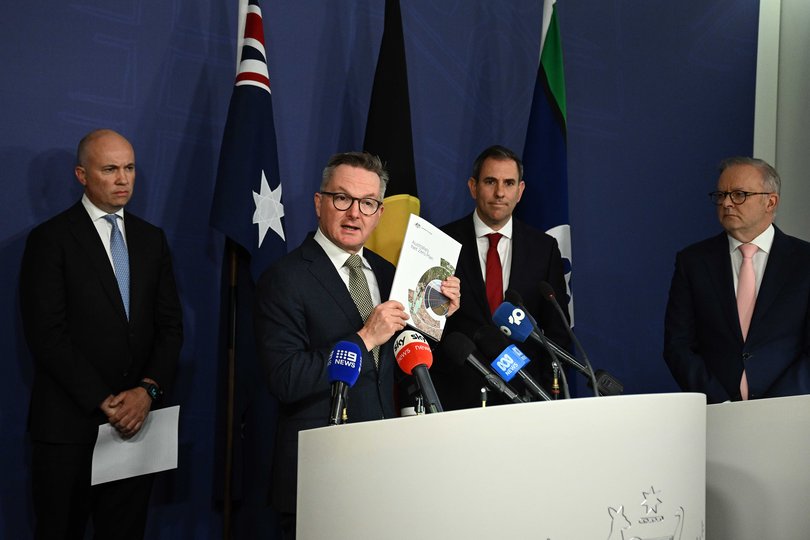Albanese Government announces 2035 target to cut emissions 62-70 per cent

The Albanese Government is counting on households and industries to do the heavy lifting after announcing its new 2035 climate target of slashing emissions by 62-70 per cent.
But it hasn’t laid out how much public money is needed or the cost to make the changes required.
Half of the cars sold between now and 2035 need to be electric vehicles, wind power capacity has to quadruple, large-scale solar triple, rooftop solar double and battery storage increase six-fold to reach the target.
Sign up to The Nightly's newsletters.
Get the first look at the digital newspaper, curated daily stories and breaking headlines delivered to your inbox.
By continuing you agree to our Terms and Privacy Policy.But the target has come under fire from environmental groups and social advocates for being too low while the Opposition has attacked the Government for failing to detail the impact on power prices.
Climate Change Minister Chris Bowen said everyone needed to “lean in” – buying EVs, installing household batteries, updating factory equipment – if the country was to achieve the new goal.

Cabinet and then Labor’s full caucus on Thursday approved the commitment to cut Australia’s emissions by 62-70 per cent on 2005 levels by 2035 under an updated Paris agreement target.
Prime Minister Anthony Albanese said the new target, which he will take to the United Nations next week, was responsible and backed by a practical plan to get there.
“We listen to the science then we act in Australia’s national interest,” he said.
“It’s the right target to protect our environment, to protect and advance our economy and jobs, and to ensure that we act in our national interest and in the interest of this and future generations.”
The target range was recommended by Climate Change Authority head Matt Kean, although it was lower than the 65-75 per cent band the Authority consulted on last year.
“It’s ambitious, but it’s absolutely feasible,” Mr Kean said.
It will require the country to more than double the average emissions cut each year compared with what’s been achieved over the past five years, from 9 million tons to 19-24Mt.
The Coalition is dead against the target
The energy sector has been the main focus over the past decade and will continue to yield the bulk of the emissions cuts over the next 10 years, but other sectors – notably resources and transport – will have to step up.
The safeguard mechanism that caps emissions from the largest polluters will be extended to require industry and resources projects to cut their emissions by about a third.
Mr Bowen said it was a whole-of-country effort.
“We hold many levers in the Federal Government, and we’re pushing those levers,” he said.
“But it’s a whole country effort. So, if the states and territories continue to lean in, if local government continues to lean in, if industries, if households continue to install a thousand batteries a day and take up EVs at high rates, then we can certainly do our best as a country.”
The goal is more ambitious than targets set by Canada or New Zealand, but falls well short of the UK’s 81 per cent on 1990s levels (about 78 per cent on 2005 levels).
The EU is reportedly considering setting a target range similar to Australia’s 62-70 per cent band.
Thursday’s net zero plan was backed by nearly $8.3 billion in government investment to help industry decarbonise, quicken the uptake of electric vehicles, and help households and sporting clubs use less energy.
But the Government wouldn’t say how much public investment would be needed over the next decade to reach the goal.
Treasury modelling based on a 65 per cent cut projected the economy would grow an average 2.5 per cent over the next 10 years and be $2.2 trillion bigger by 2050 compared with now.
Under a disorderly transition scenario – which assumes there is little emissions reduction done until 2040 and considerable policy uncertainty turning off investors – the economy would be just $1 trillion larger by 2050.
Opposition Leader Sussan Ley said the Coalition was “dead against” the target.
She rejected the modelling and said the Government’s “credibility is in tatters”, in part because it assumed Australia’s 2030 target of a 43 per cent cut would be met “when clearly it will not be”.
Australia is on track to cut emissions by 42.6 per cent by 2030.
“There is nothing in this announcement that demonstrates to Australians how much it will cost, and that’s not reasonable for households, for businesses, for the hard-working manufacturers in this country who want answers and are seeing their electricity bills skyrocket,” Ms Ley said.
The CCA advice cited analysis showing household power bills would drop 20 per cent over the next decade “under a coordinated renewables rollout”, while the Treasury modelling said people who swapped their gas cooktops, heaters and hot water systems for electric ones could save $1000 a year even after the up-front costs.
Business Council of Australia head Bran Black said achieving the target range would require significant collaboration between private and public sectors.
The peak body has estimated a 60 per cent reduction would call for about $400 million in capital investment.
“Even the lower end of the range will be challenging, requiring significant capital investment over the next decade and EPBC approvals processes to be comprehensively and quickly addressed,” Mr Black said.
WA’s Chamber of Minerals and Energy also highlighted the importance of quickly fixing environmental approvals – vital to the rollout of renewables projects and opening up a critical minerals sector – and noted that WA’s “unique decarbonisation pathway” wouldn’t drop towards zero in a linear fashion.
Greens leader Larissa Waters decried the target as an “utter failure” and “a betrayal of people and the planet”.
Environmental groups were pushing for Australia to adopt at least a 75 per cent cut – some advocated for a net zero by 2035 position – but Mr Bowen said that wasn’t achievable.
“This is the target you get when you refuse to end coal and gas exports and you refuse to end native forest logging. This is not ambition,” Senator Waters said.
“The only reason you have a range is to let you off the hook if you only hit the lower number – the target announced today is 62 per cent.”
Greenpeace said the target undermined action to limit global warming to 1.5C while the Australian Conservation Foundation labelled it timid.
“It’s awful to see the government shrug and accept the worst-case scenarios in the National Climate Risk Assessment as if they are Australia’s inevitable future: regular coastal inundation, more heat-related deaths, worse bushfires and more environmental damage,” ACF’s Gavan McFadzean said, referring to the doomsday scenarios the Government released on Monday as part of the groundwork for the target.
Treasury forecast emissions from gas use would drop 70 per cent by 2035 as most households and industry electrified, while gas exports were expected to drop by 27 per cent.
Iron ore exports were forecast to drop 11 per cent partly because it was assumed some would be redirected to domestic green steel operations but also due to declines in global demand.

